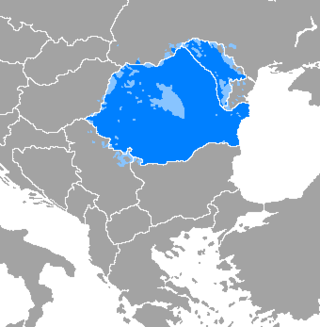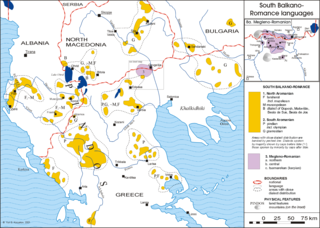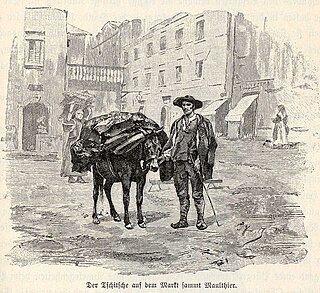
Romanian is the official and main language of Romania and Moldova. Romanian is part of the Eastern Romance sub-branch of Romance languages, a linguistic group that evolved from several dialects of Vulgar Latin which separated from the Western Romance languages in the course of the period from the 5th to the 8th centuries. To distinguish it within the Eastern Romance languages, in comparative linguistics it is called Daco-Romanian as opposed to its closest relatives, Aromanian, Megleno-Romanian, and Istro-Romanian. As a minority language it is spoken by stable communities in the countries surrounding Romania, and by the large Romanian diaspora. In total, it is spoken by 28–29 million people as an L1+L2 language, of whom c. 24 million are native speakers. In Europe, Romanian occupies the 10th position among 37 official languages.
The Istro-Romanian language is a Balkan Romance language, spoken in a few villages and hamlets in the peninsula of Istria in Croatia, as well as in the diaspora of this people. It is sometimes abbreviated to IR.

The grapheme Š, š is used in various contexts representing the sh sound like in the word show, usually denoting the voiceless postalveolar fricative /ʃ/ or similar voiceless retroflex fricative /ʂ/. In the International Phonetic Alphabet this sound is denoted with ʃ or ʂ, but the lowercase š is used in the Americanist phonetic notation, as well as in the Uralic Phonetic Alphabet. It represents the same sound as the Turkic letter Ş and the Romanian letter Ș (S-comma), the Hebrew and Yiddish letter ש, the Ge'ez (Ethiopic) letter ሠ and the Arabic letter ش.
The Istriot language is a Romance language of the Italo-Dalmatian branch spoken by about 400 people in the southwestern part of the Istrian peninsula in Croatia, particularly in Rovinj and Vodnjan. It should not be confused with the Istrian dialect of the Venetian language or the more distantly related Eastern Romance Istro-Romanian.

Gaj's Latin alphabet, also known as abeceda or gajica, is the form of the Latin script used for writing Serbo-Croatian and all of its standard varieties: Bosnian, Croatian, Montenegrin, and Serbian.

The Latin script, also known as the Roman script, is an alphabetic writing system based on the letters of the classical Latin alphabet, derived from a form of the Greek alphabet which was in use in the ancient Greek city of Cumae, in southern Italy. The Greek alphabet was adopted by the Etruscans, and subsequently their alphabet was adopted by the Romans. Several Latin-script alphabets exist, which differ in graphemes, collation and phonetic values from the classical Latin alphabet.

The Istro-Romanians are a Romance ethnic group native to or associated with the Istrian Peninsula. Historically, they inhabited vast parts of it, as well as the western side of the island of Krk until 1875. However, due to several factors such as the industrialization and modernization of Istria during the socialist regime of Yugoslavia, many Istro-Romanians emigrated to other places, be them Croatian cities such as Pula and Rijeka or places such as New York City, Trieste and Western Australia. The Istro-Romanians dwindled severely in number, being reduced to eight settlements on the Croatian side of Istria in which they do not represent the majority.
The Romanian dialects are the several regional varieties of the Romanian language (Daco-Romanian). The dialects are divided into two types, northern and southern, but further subdivisions are less clear, so the number of dialects varies between two and occasionally twenty. Most recent works seem to favor a number of three clear dialects, corresponding to the regions of Wallachia, Moldavia, and Banat, and an additional group of varieties covering the remainder of Transylvania, two of which are more clearly distinguished, in Crișana and Maramureș, that is, a total of five.

The Romanian language is widely spoken in Serbia. This country hosts large native Romanian-speaking populations, which can be divided into the ethnic Romanians in the autonomous region of Vojvodina and the Romanian/Vlachs of the Timok Valley, a geographical region in Central Serbia. The former speak the Banat Romanian, identify as Romanians and have full rights within the autonomous region. Romanian is one of the six officially recognized languages of Vojvodina. Romanian/Vlachs speak archaic varieties of the Banat and Oltenian Romanian. Some of the members of community do not identify as Romanians and their language is not recognized as Romanian within Serbia. A "Vlach language" has gone under attempted standardization in the country, using a Cyrillic alphabet. This has been criticized in Romania, and attempts to bring Romanian-language resources and education to the Timok Vlachs have been blocked by the Serbian authorities.
The Aromanian alphabet is a variant of the Latin script used for writing the Aromanian language. The current version of the alphabet was suggested in 1997 at the Symposium for Standardisation of the Aromanian Writing System in Bitola, Republic of North Macedonia and revised in 1999. It was then adopted by most Aromanian writers in North Macedonia, Serbia, Albania, Bulgaria and Romania.

The Aromanian language, also known as Vlach or Macedo-Romanian, is an Eastern Romance language, similar to Megleno-Romanian, Istro-Romanian and Romanian, spoken in Southeastern Europe. Its speakers are called Aromanians or Vlachs. Some scholars, mostly Romanian ones, consider Aromanian a dialect of Romanian.
The Moldavian dialect is one of several dialects of the Romanian language (Daco-Romanian). It is spoken across the approximate area of the historical region of Moldavia, now split between the Republic of Moldova, Romania, and Ukraine.

Sextil Iosif Pușcariu was an Austro-Hungarian-born Romanian linguist and philologist, also known for his involvement in administrative and party politics. A native of Brașov educated in France and Germany, he was active in Transylvania's cultural life and worked as a Romanian-language professor at Czernowitz in the Duchy of Bukovina. He began his scholarly career in 1906, when he was tasked with compiling a general dictionary of the Romanian language. Interested in a variety of disciplines, Pușcariu published widely and brought new ideas into Romania, as well as overseeing two monumental projects related to the language: advancing his dictionary to the letter "L", and creating an atlas of the language.

Ćić, is an ethnonym and exonym in a broader sense for all the people who live in the mountainous Ćićarija area in Croatia and Slovenia. Alongside the term Ćiribirci, in the narrow sense, it is an exonym referring to a community of the Istro-Romanians in the village Žejane in a small part of eastern Ćićarija and the villages around the former Lake Čepić west of the Učka range in Istria, Croatia.
George Giuglea was an Austro-Hungarian-born Romanian linguist and philologist.

Septimiu Albini was an Imperial Austrian-born Romanian journalist and political activist. A native of Transylvania, he attended the University of Vienna, where he was active in the local affiliate of Junimea society. Invited by Ioan Slavici, he settled in Sibiu in 1886, where he edited Tribuna newspaper and delved into political journalism for the following eight years. The period was marked by several stays in prison for press infractions. His time there came to an abrupt end in 1894, when he was sentenced to prison for having signed the Transylvanian Memorandum. Rather than undergo further incarceration, Albini fled to the Romanian Old Kingdom, where he lived in relative obscurity.

Theodor Capidan was an Ottoman-born Romanian linguist. An ethnic Aromanian from the Macedonia region, he studied at Leipzig before teaching school at Thessaloniki. Following the creation of Greater Romania at the end of World War I, Capidan followed his friend Sextil Pușcariu to the Transylvanian capital Cluj, where he spent nearly two decades, the most productive part of his career. He then taught in Bucharest for a further ten years and was marginalized late in life under the nascent communist regime. Capidan's major contributions involve studies of the Aromanians and the Megleno-Romanians, as well as their respective languages. His research extended to reciprocal influences between Romanian and the surrounding Slavic languages, the Eastern Romance substratum and the Balkan sprachbund, as well as toponymy. He made a significant contribution to projects for a Romanian-language dictionary and atlas.

Andrei Glavina was an Austro-Hungarian-born Istro-Romanian writer, professor and politician born in Šušnjevica. Known as the "Apostle of the Istro-Romanians", he is recognized for his struggle for the Istro-Romanian culture and language, being notable his book Calindaru lu rumeri din Istrie, the first in history written in this language in collaboration with Constantin Diculescu. He also managed the creation of an Istro-Romanian municipality in 1922 being the first mayor, giving classes in Istro-Romanian in the only school of the municipality.
The re-latinization of Romanian was the reinforcement of the Romance features of the Romanian language during the 18th and 19th centuries. In this period, Romanian adopted a Latin-based alphabet to replace the Cyrillic script and borrowed many words from French as well as from Latin and Italian, in order to acquire the lexical tools necessary for modernization. This process coined words for recently introduced objects or concepts (neologisms), added Latinate synonyms for some Slavic and other loanwords, and strengthened some Romance syntactic features.
The Aromanian Missal is an anonymous Aromanian-language instructive liturgical book (missal) variously referred to as dating from the beginning, the first half, the middle and the second half of the 18th century. It is the first extensive text in Aromanian, and includes translations of sermons and other religious texts into Aromanian. The Aromanian Missal is believed to have been written in Moscopole, once a prosperous Aromanian city, and uses the Greek alphabet due to archaic forms of Greek being considered the appropriate language for high and literary functions in those times within the Balkans. In recent times, the text of the liturgy has begun to circulate more actively among the Aromanians in Albania with support from the Aromanian diaspora. In a 2002 study on the Aromanians, German researcher Thede Kahl stated that priest Thomai sang this Aromanian-language liturgy at the St. Nicholas Church of Moscopole.












